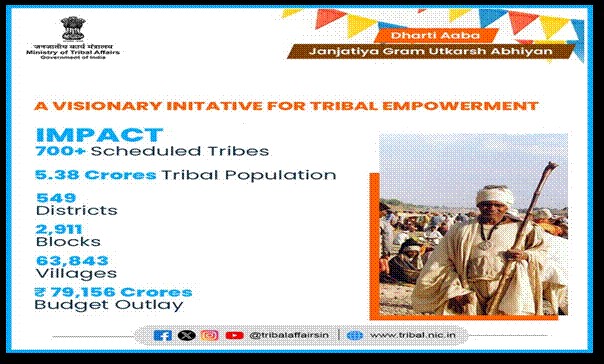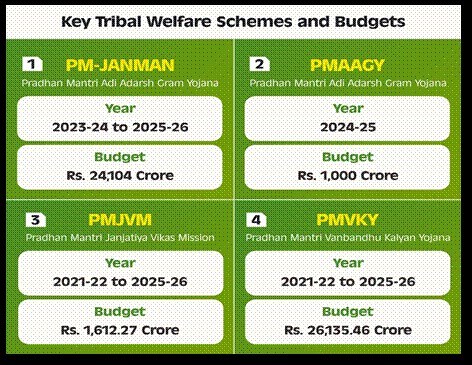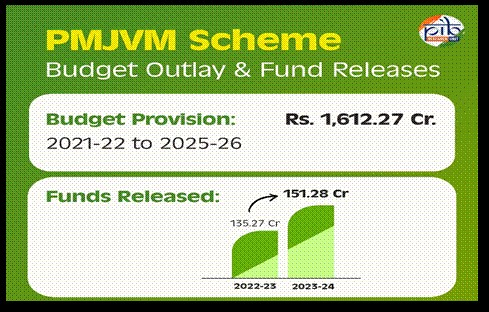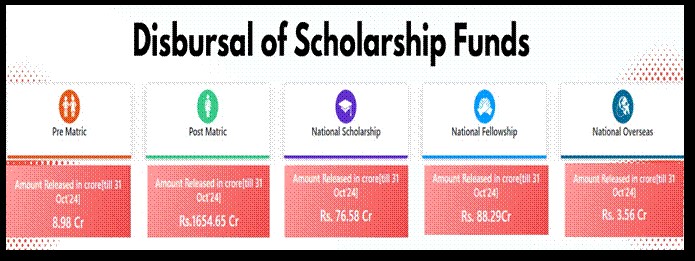Ministry of Tribal Affairs
Empowering Tribal Society: Initiatives for Socio-Economic Development
Posted On: 15 NOV 2024 10:43AM
When the right efforts are made, the right results follow. I believe that our tribal youths will make progress, and the nation will benefit from their potential.
~ Prime Minister Shri Narendra Modi
Introduction

India's Scheduled Tribe (ST) population, comprising 10.42 million people (8.6% of the total population) across over 705 distinct groups, often resides in remote areas. To uplift these communities, the government has introduced various welfare schemes aimed at socio-economic empowerment, sustainable development, and the preservation of their rich cultural heritage. These initiatives are designed to improve living standards, promote education, and ensure inclusive growth for tribal populations.
Honouring and Celebrating India’s Tribal Communities[2]
As part of its commitment to tribal empowerment, the government has launched several initiatives.
Further, to honor the legacy and heritage of tribal communities, it began celebrating Janjatiya Diwas on November 15th. This date marks the birth anniversary of Bhagwan Birsa Munda, revered by tribal communities across the country. Birsa Munda fought courageously against the exploitative British colonial system and led the movement for freedom. Since 2021, Janjatiya Gaurav Divas has been celebrated nationwide to remember the sacrifices of tribal freedom fighters. This year, on Birsa Munda’s 150th birth anniversary, the Prime Minister will unveil a special commemorative coin and postal stamp, while also launching development projects worth over Rs 6,640 crore to uplift tribal communities, particularly in rural and remote areas.
Budget for Tribal Empowerment and Progress[3]

To ensure the overall development of tribal society, the Union Budget 2024-25 has allocated Rs. 13,000 crore to the Ministry of Tribal Affairs. Under the Development Action Plan for Scheduled Tribes (DAPST), formerly known as the Tribal Sub-Plan (TSP), 42 Ministries/Departments are committed to earmarking funds for tribal development in sectors like education, health, agriculture, and infrastructure. The DAPST fund allocation has grown 5.8 times since 2013-14, reaching Rs. 1,24,908 crore in 2024-25.
Schemes for the Welfare of Tribes
Over the years, several schemes have been introduced to support the socio-economic development of tribal communities, with special attention to the needs of Particularly Vulnerable Tribal Groups (PVTGs). These programs are designed to help improve their living conditions and ensure their inclusion in mainstream society.
Launch of Dharti Aaba Janjatiya Gram Utkarsh Abhiyan[4]
On October 2, 2024, Prime Minister Narendra Modi launched the Dharti Aaba Janjatiya Gram Utkarsh Abhiyan in Hazaribag, Jharkhand. With an outlay of over ₹79,156 crore, this ambitious program aims to address critical gaps in social infrastructure, health, education, and livelihood development across approximately 63,843 tribal villages.

Pradhan Mantri Janjati Adivasi Nyaya Maha Abhiyan (PM-JANMAN)[5]

On November 15, 2023, during Janjatiya Gaurav Divas in Khunti, Jharkhand, the Prime Minister launched the Pradhan Mantri Janjati Adivasi Nyaya Maha Abhiyan (PM-JANMAN) to uplift Particularly Vulnerable Tribal Groups (PVTGs). PM-JANMAN aims to improve the quality of life for PVTG communities through targeted support in areas such as safe housing, clean drinking water, education, health, road and telecom connectivity, electrification, and sustainable livelihoods.
The Pradhan Mantri Adi Adarsh Gram Yojana (PMAAGY)
The 'Special Central Assistance to Tribal Sub-Scheme (SCA to TSS)', launched in 1977-78, aimed at bridging developmental gaps for tribal welfare. In 2021-22, the scheme was revamped as the Pradhan Mantri Adi Adarsh Gram Yojana (PMAAGY), focusing on providing basic infrastructure in villages with a significant tribal population. Under PMAAGY, 36,428 villages with at least 50% tribal population have been identified for development, including those in Aspirational Districts.
Eklavya Model Residential Schools (EMRS)
The Eklavya Model Residential Schools (EMRS) scheme, launched in 2018-19, aims to provide quality education to tribal students, focusing on their academic, cultural, and skill development. On October 2, 2024, the Prime Minister inaugurated 40 EMRS and laid the foundation for 25 more, with an investment of over Rs 2,800 crore. So far, 728 EMRS have been approved.
Pradhan Mantri Janjatiya Vikas Mission (PMJVM)

PMJVM aims to boost tribal entrepreneurship and promote the "Vocal for Local by Tribal" initiative. It focuses on helping tribal communities make better use of natural resources, including Minor Forest Products (MFPs) and non-MFPs, by supporting local product-based businesses.
Pradhan Mantri Vanbandhu Kalyan Yojana (PMVKY)[6]
Launched on October 28, 2014, the Pradhan Mantri Vanbandhu Kalyan Yojana (PMVKY) is a transformative initiative designed to address the unique challenges faced by India’s tribal communities. The scheme aims to empower tribal communities, enhance socio-economic conditions, and preserve their cultural heritage.
Key Government Scholarships for Tribal Empowerment
Scholarships are also available to assist tribal students, aiming to lower dropout rates and foster their educational progress. These financial aids ensure that tribal communities have greater access to quality education and the chance to build a better future.
1. Pre-Matric and Post-Matric Scholarship Schemes
- Pre-Matric Scholarship: Financial assistance for ST students in Classes IX and X, promoting the transition to secondary education.
- Post-Matric Scholarship: Financial aid for ST students from Class XI to post-graduate courses, supporting higher education.
2. National Overseas Scholarship for ST Students : This scheme offers meritorious ST students the chance to pursue post-graduate, doctoral, and post-doctoral studies at international universities.

3. National Fellowship for ST Students: This fellowship scheme supports tribal students pursuing higher education through a fully digital process, ensuring timely financial assistance and grievance redressal via DigiLocker integration.
Financial Support and Self-Employment Schemes
The government has launched several schemes to empower tribal communities, with a key focus on income generation and economic development. One such initiative, the National Scheduled Tribes Finance and Development Corporation (NSTFDC), provides concessional loans to support self-employment and income-generating activities for Scheduled Tribes, such as
- Term Loan Scheme: This scheme provides loans for income-generating projects costing up to ₹50 lakh per unit.
- Adivasi Mahila Sashaktikaran Yojana (AMSY): Focused on empowering Scheduled Tribe women, this scheme offers loans for income-generating activities costing up to ₹2 lakh per unit.
- Micro Credit Scheme for Self-Help Groups (SHGs): Under this scheme, NSTFDC provides loans of up to ₹5 lakh per SHG and ₹50,000 per member.
- Adivasi Shiksha Rin Yojana (Education Loan): This scheme supports Scheduled Tribe students pursuing professional or technical education in India by providing financial assistance of up to ₹10 lakh.
Initiatives for Better Health Outcomes
The government has launched several key health initiatives aimed at improving the well-being of tribal communities. The Sickle Cell Anaemia Elimination Mission, launched on July 1, 2023, focuses on eradicating Sickle Cell Disease (SCD) through awareness campaigns, universal screening, and affordable care, with a special emphasis on tribal populations in Central, Western, and Southern India. Mission Indradhanush ensures full immunization for children up to 2 years and pregnant women, with a focus on tribal communities, and has expanded to include free COVID-19 vaccines. The Nikshay Mitra Initiative provides diagnostic, nutritional, and vocational support to tuberculosis (TB) patients, many of whom are from tribal areas, aiming to improve TB treatment and outcomes.
Research and Cultural Preservation Initiatives
In addition to welfare and development schemes, the government has also launched initiatives focusing on research and preservation of tribal culture. These programs aim to enhance understanding of tribal communities’ socio-economic challenges, promote their heritage, and support research in various fields.
Particularly Vulnerable Tribal Groups (PVTGs) Development Program
The Ministry of Tribal Affairs has been implementing the Development of Particularly Vulnerable Tribal Groups (PVTGs) scheme to support the socioeconomic development and welfare of the most vulnerable tribal communities. Aimed at addressing gaps for the 75 identified PVTG communities. From 2023-24, this scheme has been subsumed under the PM JANMAN initiative.
Support to Tribal Research Institutes (TRIs)
TRIs play a crucial role in preserving tribal culture and addressing their socio-economic challenges. The Support to TRIs scheme promotes research and documentation on tribal welfare, languages, traditions, and medicinal practices, while also organizing cultural festivals and exchange programs.
Tribal Research Information, Education, communication and Events (TRI-ECE)
Under the scheme, Ministry invites guests for Republic Day celebration, organizes festivals, exhibitions & competitions at the state and/or national level. The funds are also provided for publicity & Advertisement including mass awareness and media.
Rs. (in crores)
|
Name of the Scheme
|
BE for 2022-23
|
BE for 2023-24
|
|
Tribal Research Information, Education, communication and Events (TRI-ECE)
|
15.00
Advertising and Publicity – 1.50
General – 7.00
Other Charges – 6.50
|
25.00
Advertising and Publicity – 3.00
General – 7.00
Other Charges – 15.00
|
Conclusion
The government has launched numerous initiatives to empower tribal communities, with a strong emphasis on education, healthcare, and socio-economic development. By increasing awareness and promoting unity, these efforts help preserve tribal cultures while enhancing their living standards and integrating them into India’s broader progress. Through these initiatives, tribal communities are not only uplifted but also positioned to play a vital role in the nation’s growth. This aligns with the vision of "Sabka Saath, Sabka Vikas", ensuring that all communities, including tribal groups, move forward together in a spirit of inclusivity and development.
References
Empowering Tribal Society: Initiatives for Socio-Economic Development
*********
Santosh Kumar/ Ritu Kataria/ Kamna Lakaria
(Backgrounder ID: 153421)
Visitor Counter : 77